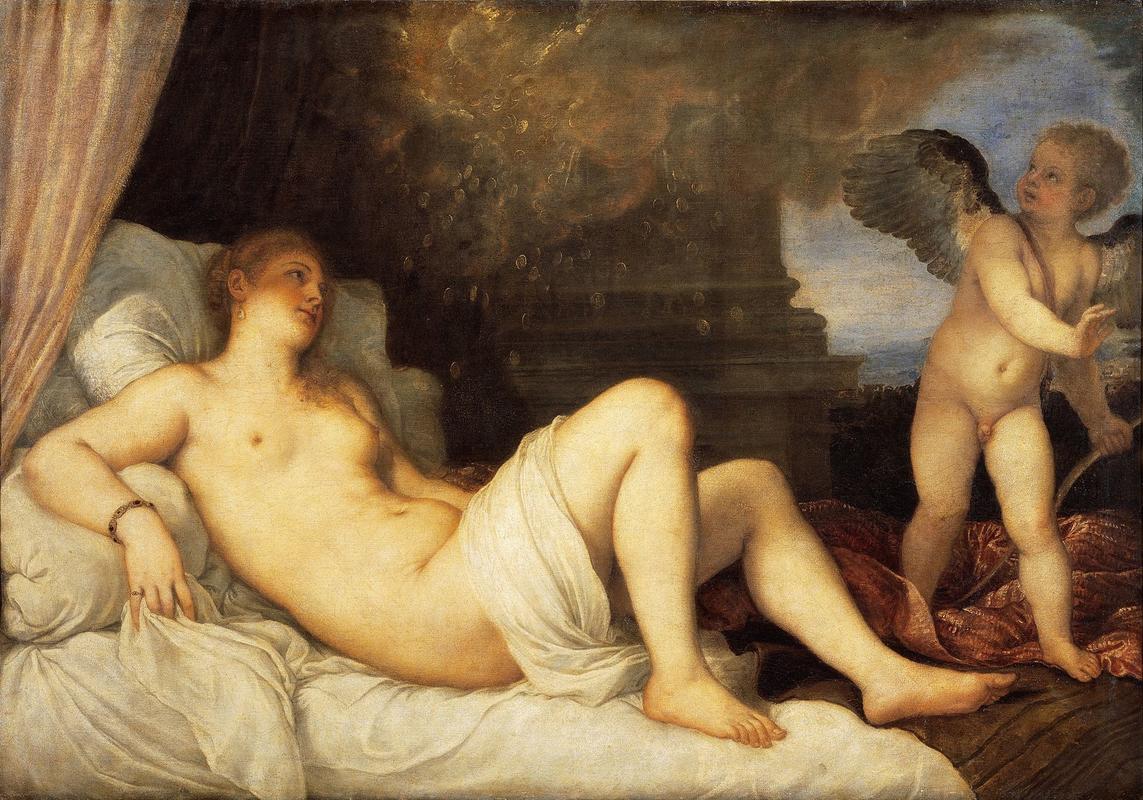More about Danaë

Contributor
Titian turns the story of Danaë into classical porn for Cardinal Alessandro Farnese.
Cardinal Alessandro Farnese, the customer who commissioned Titian’s Danaë with Eros, has something in common with the subject of the painting’s lover: they both shouldn’t have had a mistress! Alas, that’s not how the Greek gods or the Renaissance-era cardinals functioned.
In Greek mythology, Danaë of Argos is the unfortunate daughter of King Acrisius who locked away and imprisoned his daughter all because a prophecy said her son will be the cause of her father’s death. Talk about selfish. In spite of Acrisius’ efforts to ruin his daughter’s life, Danaë is visited by Zeus who appears to her in the form of a golden shower of rain--or in some myths as a rainfall of golden coins. From this tryst, Danaë and Lord Always-Shoots-Straight sire a son named Perseus (Yes, the Perseus who killed Medusa and saved his mom from being raped by another mean king by turning everyone to stone.) Well, prophecy is a b*itch, so Perseus ends up killing Acrisius years later by way of a poorly thrown discus, making Danaë’s suffering pointless.
Titian’s 1544 version of Danaë and Zeus’ love dungeon was created for Cardinal Farnese. There was speculation that the features of Titian’s Danaë were based upon those of Farnese’s mistress Angela, but considering this painting inspired a series of paintings (four other portrayals of Danaë, two sensual paintings of Diana, and one naughty rendering of Venus and Adonis) in which Danaë is depicted with the same features as the original, it is safe to say Angela’s infamy only lives on through word of mouth these days.
This painting is the only one of the series in which Danaë has any sort of cloth covering her voluptuous body, yet the intense sensuality of the piece--have you seen her hands clutching the bed sheets? Get it, Danaë!-- inspired Michael O’Sullivan of The Washington Post to notice, “The effect isn’t quite porn, but it’s erotic as heck.” A guy who worked under Farnese back in the day made a similar observation when he told his boss that this painting would make a prior nude painting “look like a nun by comparison.” C’mon guys. If you were locked in a dungeon forever you’d probably always chill in your birthday suit too. Let Danaë live.
Sources
- Atsma, Aaron J. "DANAE." THEOI GREEK MYTHOLOGY. Accessed June 11, 2017. http://www.theoi.com/Heroine/Danae.html.
- Biography.com Editors. “Titian.” The Biography. A&E Television Networks. 11 July 2017. https://www.biography.com/people/titian-21322389
- Karas, Michael and Charilaos Megas. “Danae” Greek Mythology. 11 July 2017. https://www.greekmythology.com/Myths/Mortals/Danae/danae.html
- O’Sullivan, Michael. “After almost 500 years, Titian’s ‘Danaë’ still makes you blush.” The Washington Post. 11 July 2017. https://www.washingtonpost.com/entertainment/museums/after-almost-500-y…
- “Titian.” The National Gallery. 11 July 2017. https://www.nationalgallery.org.uk/artists/titian
- “Titian’s Danae from the Capodimonte Museum, Naples.” The National Gallery. 11 July 2017. https://www.nationalgallery.org.uk/artists/titian
Featured Content
Here is what Wikipedia says about Danaë (Titian, Capodimonte)





The Venetian painter Titian and his workshop made at least six versions of the same composition showing Danaë (or Danaë and the Shower of Gold), painted between about 1544 and the 1560s. The scene is based on the mythological princess Danaë, as – very briefly – recounted by the Roman poet Ovid, and at greater length by Boccaccio. She was isolated in a bronze tower following a prophecy that her firstborn would eventually kill her father. Although aware of the consequences, Danaë was seduced and became pregnant by Zeus (in Roman mythology Jupiter), who, inflamed by lust, descended from Mount Olympus to seduce her in the form of a shower of gold.
Though the composition, especially the main figure, is essentially the same, the six or more versions vary considerably. The major surviving versions are in Naples, London, Madrid, Vienna, Chicago, and St. Petersburg. The voluptuous figure of Danaë, with legs half spread, hardly changes, and was probably traced from a studio drawing or version. Her bed and its hangings are another constant. Other elements vary considerably; the first version, now in Naples, was painted between 1544–46, and is the only one with a figure of Cupid at the right, rather than an old woman catching the shower of gold. She is a different figure at each appearance, though the pose in the Hermitage follows the Prado version. The small dog resting at Danaë's side in the Prado and Chicago versions is generally absent.
The works influenced the compositions of many artists including Rembrandt, Anthony van Dyck and Gustav Klimt, who all painted versions of the scene. Giorgio Vasari recounts a visit with Michelangelo to Titian's studio, where they saw the original in progress. Michelangelo praised Titian's use of colour in the Madrid painting, though later, in private, he was critical of Titian's draftsmanship.
Check out the full Wikipedia article about Danaë (Titian, Capodimonte)












